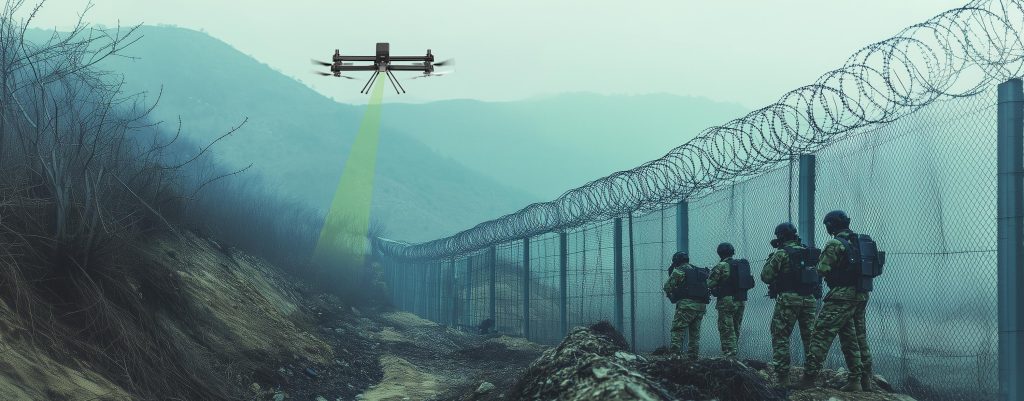
AI-Powered Drones for Real-Time Border Patrol and Threat Detection
Border security often evokes images of armed guards in camouflage patrolling along barbed wire fences that mark out state territories with no man’s land in between. In recent years, national border security has been the subject of dispute, which often escalates into armed conflict. Leaky borders also present governments with a serious threat to national security, over and above the challenge of curbing illegal immigration. As AI and robotic technology evolve to address challenges in nearly every sphere of human, animal, and even plant life, it is inevitable that solutions for border surveillance and threat protection can be found in the confluence of these technologies in the form of unmanned aerial vehicles (UAVs),or simply drones.
The evolution of border security
Over the years, the approach to border patrol and security has evolved from trusting wire fences to keep intruders out to armed guards patrolling along border fences to using surveillance cameras in addition to the fences and patrolling measures. The introduction of air patrol of borders boosted visibility and security but also brought in a massive increment in costs, making it a less viable option. All these measures, even together, leave a gap in territories with expansive and varied terrain, making it possible for unwanted elements, human or otherwise, to sneak in.
The advent of AI-powered drones for surveillance of national borders has revolutionized border patrol and threat detection by bringing in the advantage of real-time information update, a wide field of view, reduced impact to guards, and increased access to complex terrain, all while bringing down costs associated with border patrol.
A bird’s eye view of the advantages of leveraging drones
AI-powered drones represent a significant advancement in border security, offering enhanced surveillance capabilities, cost efficiency, and improved safety for personnel. As technology continues to evolve, the integration of AI in drone operations is likely to play an increasingly vital role in securing borders around the world. By leveraging these cutting-edge tools, border patrol agencies can enhance their operational effectiveness while addressing both security and ethical considerations.
Enhanced surveillance capabilities
AI-powered drones are equipped with advanced sensors and cameras that provide real-time surveillance over vast and often inaccessible border areas. These drones can cover large territories much more efficiently than ground patrols or static surveillance systems. With high-resolution imaging and thermal cameras, they can detect human presence, vehicles, and other potential threats even in low-visibility conditions, such as nighttime or harsh weather.
Autonomous operation and real-time decision-making
One of the significant advantages of AI integration is the ability of drones to operate autonomously. AI algorithms enable these drones to patrol predefined areas, identify anomalies, and respond to potential threats without human intervention. This autonomy allows for continuous monitoring and rapid response to any suspicious activity, significantly reducing response times compared to traditional patrol methods.
Cost efficiency
Deploying AI-powered drones can lead to substantial cost savings for border patrol agencies. Traditional surveillance methods often require extensive manpower, infrastructure, and maintenance. Drones, on the other hand, require fewer personnel to operate and maintain, leading to reduced operational costs. Moreover, the scalability of drone fleets allows agencies to increase or decrease surveillance coverage as needed without significant additional expenses.
Enhanced data collection and analysis
AI-powered drones collect and analyze vast amounts of data, providing valuable insights for border security operations. These drones can process information in real-time, identifying patterns and predicting potential threats. The data collected can be used to optimize patrol routes, improve resource allocation, and enhance overall security strategies.
Increased safety for personnel
By deploying drones for surveillance and reconnaissance, border patrol agencies can minimize the risks faced by personnel. Drones can be sent into potentially dangerous areas, reducing the need for human presence in high-risk situations. This not only ensures the safety of border patrol agents but also allows them to focus on more critical tasks that require human judgment and intervention.
Environmental and ethical considerations
AI-powered drones offer an environmentally friendly alternative to traditional patrol vehicles, which often rely on fossil fuels. Drones typically have lower carbon footprints and can operate in environmentally sensitive areas with minimal disruption. Additionally, using drones for surveillance can help ensure compliance with human rights by reducing the likelihood of confrontations and excessive use of force.
Regulatory and compliance issues in India
In India, deploying AI-powered drones for border patrol is subject to a complex regulatory environment. Agencies must comply with the guidelines mentioned in Drone Rules, 2021, which outline specific requirements for drone classification, operational limits, and mandatory permissions. Additionally, drones used for border security must align with national security protocols and ensure data integrity to prevent unauthorized access. Navigating these regulations requires close collaboration with government bodies like the Directorate General of Civil Aviation (DGCA) and adherence to strict compliance standards. Addressing these regulatory challenges is crucial to fostering the safe and effective deployment of drones in India’s border regions.
Challenges and opportunities
Despite their numerous benefits, the adoption of AI-powered drones for border security comes with its own set of challenges. Technical limitations, such as the need for robust connectivity and battery life, can hinder continuous operations. Additionally, concerns about data privacy and the potential misuse of AI-driven surveillance must be addressed. However, these challenges also present opportunities for innovation, such as the development of more energy-efficient drones, advanced encryption methods, and AI algorithms that are transparent and ethical. By tackling these challenges head-on, border security agencies can unlock the full potential of this technology.
Looking ahead
The unique ability of AI-powered drones to provide real-time insights and autonomous responses to potential threats. Places them at a unique advantage over human patrolling and reliance on fences. By leveraging AI for continuous monitoring and rapid decision-making, border patrol agencies can significantly improve their ability to detect and mitigate risks. As this technology continues to evolve, it promises to be an indispensable tool in maintaining secure and well-monitored borders while ensuring the safety and efficiency of personnel. Looking ahead, the continued advancements in AI and drone technology will likely introduce even more sophisticated threat detection and response capabilities, further solidifying their role as a cornerstone of modern border security strategies.

Hi, this is a comment.
To get started with moderating, editing, and deleting comments, please visit the Comments screen in the dashboard.
Commenter avatars come from Gravatar.